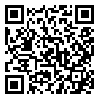Sat, Dec 13, 2025
[Archive]
Volume 39, Issue 1 (1-2025)
Med J Islam Repub Iran 2025 |
Back to browse issues page
Download citation:
BibTeX | RIS | EndNote | Medlars | ProCite | Reference Manager | RefWorks
Send citation to:



BibTeX | RIS | EndNote | Medlars | ProCite | Reference Manager | RefWorks
Send citation to:
Arshadi H, Hosseini Golkar M, Zahedi Z, Ashrafi M, Okhovati M. Bridging the Gap: Scenario Planning for Science and Technology in Breast Cancer. Med J Islam Repub Iran 2025; 39 (1) :139-153
URL: http://mjiri.iums.ac.ir/article-1-9450-en.html
URL: http://mjiri.iums.ac.ir/article-1-9450-en.html
Medical Library and Information Sciences Department, Faculty of Management and Medical Information Sciences, Kerman University of Medical Sciences, Medical University Campus, Haft-Bagh Highway, Kerman, Iran , mokhovati@kmu.ac.ir
Abstract: (2112 Views)
Background: The convergence of scientific research and technological breakthroughs is critical to societal health. However, both academic literature and patents can grow at separate rates, leading to gaps in fields like breast cancer. This study aims to identify and bridge the gap between science and technology in breast cancer research through scenario planning.
Methods: This research is a foresight study conducted using the scenario technique method. A total of 191,871 papers and 9085 patents on breast cancer, published between 2012 and 2021, were analyzed using data from the Web of Science Core Collection and PATSTAT databases. Text mining was conducted using the Latent Dirichlet Allocation (LDA) topic modeling technique with Python libraries to identify subject clusters and areas of asynchrony. The scenario technique was then developed, aimed at bridging the gap between science and technology.
Results: Our findings revealed that scientific output in breast cancer has greatly surpassed technical advancements, indicating gaps in several key domains. Scientific papers in our dataset, mostly concentrated on the complexities of breast cancer—including genetic mutations, hormone receptors, dietary factors, and environmental influences—whereas the analyzed patents frequently addressed lesser-known areas such as herbal medicine, medical devices, protective clothing, and micro ribonucleic acid therapies. To fill these gaps, 4 scenarios were created and, some effective actions for each scenario were recommended.
Conclusion: Different priorities emerged across the 16 proposed actions for the 3 specific scenarios—excluding the favorable scenario. In all scenarios, enhancing stakeholder ties, establishing cooperative networks, and developing collaborative incentive systems were identified as key strategies for diminishing the gap between science and technology in breast cancer.
Methods: This research is a foresight study conducted using the scenario technique method. A total of 191,871 papers and 9085 patents on breast cancer, published between 2012 and 2021, were analyzed using data from the Web of Science Core Collection and PATSTAT databases. Text mining was conducted using the Latent Dirichlet Allocation (LDA) topic modeling technique with Python libraries to identify subject clusters and areas of asynchrony. The scenario technique was then developed, aimed at bridging the gap between science and technology.
Results: Our findings revealed that scientific output in breast cancer has greatly surpassed technical advancements, indicating gaps in several key domains. Scientific papers in our dataset, mostly concentrated on the complexities of breast cancer—including genetic mutations, hormone receptors, dietary factors, and environmental influences—whereas the analyzed patents frequently addressed lesser-known areas such as herbal medicine, medical devices, protective clothing, and micro ribonucleic acid therapies. To fill these gaps, 4 scenarios were created and, some effective actions for each scenario were recommended.
Conclusion: Different priorities emerged across the 16 proposed actions for the 3 specific scenarios—excluding the favorable scenario. In all scenarios, enhancing stakeholder ties, establishing cooperative networks, and developing collaborative incentive systems were identified as key strategies for diminishing the gap between science and technology in breast cancer.
Type of Study: Original Research |
Subject:
Oncology
Send email to the article author
| Rights and permissions | |
 |
This work is licensed under a Creative Commons Attribution-NonCommercial 4.0 International License. |








